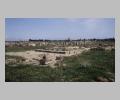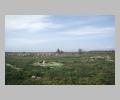| Context: | Metapontum |
| Type: | Temple |
| Summary: | Oldest temple in the Metapontum sanctuary, preserved only in its foundations. |
| Date: | ca. 600 BC - ca. 475 BC |
| Dimensions: | Since so little of the temple is preserved, dimensions are uncertain, although the preserved foundations of oikos CI measure ca. 9.30 m. x 6.40 m. Temple CII was certainly larger. |
| Region: | Lucania |
| Period: | Archaic |
Plan:
The final groundplan of the temple is unclear; a rectangular structure, at least 9.30 m. in length, is preserved. In its second construction phase, the temple was rebuilt and enlarged, and although little remains of the superstructure of this temple also, it is reconstructed as distyle in antis, without a peristyle.
Date Description:
Ceramic and votive evidence from the foundations of Temple CI date to the end of the seventh century B.C. The appearance of the foundations supports this date. The terracotta frieze is datable to ca. 600-580 B.C. The second construction phase is dated to ca. 500-475, based on the style of the preserved architectural terracottas and the marble roof sima.
History:
The earliest structure was presumably a small oikos, known as CI, dating to ca. 600 B.C. To this structure belongs the fragmentary terracotta frieze. In the late sixth century or early fifth century B.C., this modest building was incorporated into a larger temple, Temple CII. Architectural fragments from the roof indicate a restoration in the early fourth century B.C.
Other Notes:
Fragments of a terracotta frieze deriving from the superstructure of Temple CI provide important art historical information on the nature of archaic art in the sanctuaries of Southern Italy. The frieze is decorated in low relief with a processional scene, including veiled females in carriages drawn by donkeys (?) and led by a youth, and walking veiled females who appear to bear gifts.
The name of the divinity to whom the Temple was dedicated is uncertain, although Adamesteanu proposed that it may have been dedicated to Athena, on the basis of an archaic inscription referring to Athena found at the south side of the temple
Other Bibliography:


